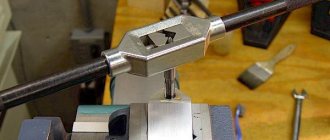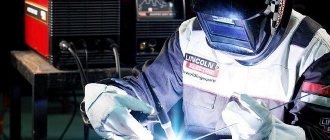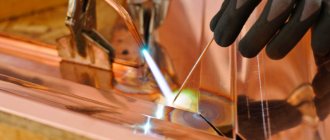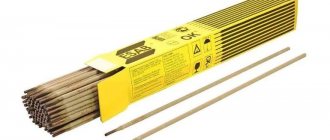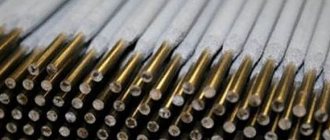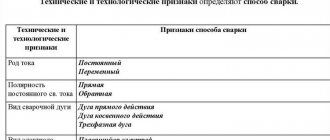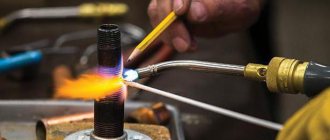In this article we will tell you how to choose the right tungsten electrode for argon arc welding, what types of tungsten there are, their distinctive properties, and how the composition affects the quality of the weld.
But at the very beginning, we would like to draw your attention to the fact that tungsten electrodes of the WL-15, WL-20, WC-20, WY-20 and WZ-8 brands have appeared in the range of PTK branded products.
Our tungsten electrodes have undergone X-ray microanalysis of elemental composition at the National Research Institute. We conducted this paid study on our own initiative in order to demonstrate to dealers and consumers the highest quality of our products.
The analysis was carried out on a Tescan Vega II scanning electron microscope, which allows you to obtain SEM images and analyze the elemental composition in real time, which is necessary for quality control of products and materials.
You can familiarize yourself with the research protocols and the results of the elemental composition of tungsten electrodes produced by PTK in the reporting documents.
What is a tungsten electrode and where is it used?
A tungsten electrode is a round rod made of pure tungsten or tungsten with the addition of additives (alloying additives). Tungsten is used in TIG welding with a non-consumable electrode.
If you have a question, why “non-melting”, then the answer is very simple. Tungsten has the highest melting point among pure metals (3422°C). Therefore, argon arc welding is performed with straight polarity, because the temperature of the cathode spot (-) reaches 3000 °C, and the temperature of the anode spot (+) reaches 4000 °C. Because of this, the electrode is not consumed during welding, but burns out.
Electrodes can have a clean or polished surface. A distinctive feature of clean electrodes is that they are chemically cleaned, i.e. The workpieces are etched to remove oxides and contaminants from the surface.
This is the most labor-intensive and costly procedure, therefore it is used much less frequently in industrial production. The ground surface of the electrodes suggests that the electrodes may have been processed by forging, broaching, or centerless grinding. The latter method is the most popular; as a result of this manufacturing, the thermal conductivity of the electrodes improves.
The diameter and length of tungsten electrodes can vary. Standard electrodes have a length from 50 to 175 mm, and a nominal diameter from 0.5 to 10 mm. In Russia, electrodes are manufactured according to GOST 23949-80, TU 48-19-27-91, TU 48-19-39-85, 48-19-221-83 and TU 48-19-527-83 from pure tungsten and tungsten with activating alloying additives of rare earth metals.
Tungsten electrodes are used exclusively in TIG welding, due to the prevention of oxides on the surface of the connecting seam. Welding occurs in a shielding gas environment, which protects the welding zone from exposure to oxygen.
This type of welding uses a chemically inert gas (noble gas). These gases include helium, argon and special welding mixtures. A distinctive feature of these gases is that they have very low chemical reactivity, in other words, they do not interact with the metal of the weld. These gases are also colorless and odorless.
Color change over time
If the ring begins to darken or show signs of rust, it is a piece of mediocre quality jewelry. Rings made of tungsten, titanium, thisten and stainless steel (without color coating) do not change the original shade, are not afraid of exposure to ultraviolet radiation, water (even sea water), are resistant to corrosion, and do not oxidize when interacting with the skin (unlike some silver jewelry) .
| Tungsten ring | Titanium ring | Thisten ring | 316L steel ring |
| Do not change color, do not darken, do not fade, do not rust. |
A change in the color of the tungsten ring, as well as models made of thisten or titanium, is a sign of an increased content of impurities in the metal alloy. As well as the darkening of the steel ring - the fact that its composition does not correspond to the proven grade of 316L steel.
Alphanumeric marking of tungsten electrodes
In Russia, 2 types of marking of tungsten electrodes can be used and applied - this is the classification according to GOST, TU and the international classification according to ISO 6848. Let us briefly consider these types of markings.
Marking of domestic electrodes according to GOST and TU
Products that are manufactured in Russia and comply with the established GOST and TU contain the letters “E” and “B” in their name; they come first in the name and mean “tungsten electrode.” Further, the name indicates the chemical composition of the additives and their mass fraction.
- EHF - “H” - pure (tungsten not less than 99.92%);
- EVL - “L” - lanthanum (mass fraction of lanthanum oxide from 1.1 to 1.4%);
- EVL-2 - “L” - lanthanum (mass fraction of lanthanum oxide from 1.4 to 1.6%)
- EVI-1 - “I” - yttrium (mass fraction of yttrium oxide from 1.5 to 2.3%)
- EVI-2 - “I” - yttrium (mass fraction of yttrium oxide from 2.0 to 3.0% and tantalum 0.1%)
- EVI-3 - “I” - yttrium (mass fraction of yttrium oxide from 2.5 to 3.5% and tantalum 0.1%);
- EVT-15 - “T” - thorium (mass fraction of thorium dioxide from 1.5 to 2.0%).
International marking according to ISO 6848 standards
Most tungsten alloys have been standardized by the International Organization for Standardization in ISO 6848. The table below shows the alphanumeric designations and percentage composition of alloying additives.
| Letter designation | Color code | Mass fraction of alloying additives |
| W.P. | Green | – |
| WC-20 | Grey | ~2% |
| WL-10 | Black | ~1% La₂O₃ |
| WL-15 | Gold | ~1.5% La₂O₃ |
| WL-20 | Blue | ~2% La₂O₃ |
| WT-10 | Yellow | ~1% ThO₂ |
| WT-20 | Red | ~2% ThO₂ |
| WT-30 | Violet | ~3% ThO₂ |
| WT-40 | Orange | ~4% ThO₂ |
| WY-20 | Blue | ~2% Y₂O₃ |
| WZ-3 | Brown | ~0.3% ZrO₂ |
| WZ-8 | White | ~0.8% ZrO₂ |
What are alloying additives and rare earth metals?
We have looked at the alphanumeric designations of tungsten electrodes, now it’s time to talk about the rare earth metals (elements) that are part of the electrodes, or rather, alloying additives (additives).
Rare earth metals are a group of 17 elements that include scandium, yttrium, lanthanum and lanthanides. All these metals are silvery-white in color, similar in chemical and physical properties, and form refractory oxides that are practically insoluble in water.
These metals received the name “rare earth” due to the fact that they are rarely found in the earth’s crust, and these metals are also difficult to mine and industrially produce.
The most commonly used additives in tungsten welding electrodes are lanthanum, cerium, yttrium, zirconium and thorium.
Is it possible to change the size
The size of a tungsten, titanium or thistene ring cannot be reduced or increased. The equipment of traditional jewelry workshops is not designed to process such hard metals.
We attribute a similar property to 316L steel. If you don’t believe me, try to find a craftsman who will resize the steel ring. And if you find a specialist with the appropriate equipment, the cost of the service is unlikely to please you. The price tag will be comparable to resizing a gold ring and will likely exceed the original cost of your ring.
| Tungsten rings | Titanium rings | Tisten rings | 316L steel rings |
| Can't resize |
A profitable alternative when buying rings online is to choose a store that provides a free exchange service. The opportunity to exchange a ring of the wrong size by mail or when visiting a showroom in our store is available within 30 days after receiving the order. To reduce the likelihood of making an erroneous choice, we recommend that you familiarize yourself with methods for determining ring size at home before purchasing online.
Properties of filler metals and their influence on the quality of the weld
Tungsten Electrode WP (Green)
Pure tungsten electrodes are classified as WP and have a green color code. The tungsten content in them is at least 99.5%.
- Features: Electrodes marked WP provide high arc stability, but have poor heat resistance and electronic emission. Due to this limited thermal load, the working end of the electrode must be sharpened into a round shape (ball).
- Current type: Designed for welding with sinusoidal current (AC) in argon or helium.
- Metal: This type of electrode is designed for welding aluminum, magnesium, nickel and their alloys.
Due to the fact that WP electrodes were used on transformer equipment, and now most welding equipment is inverter, the need for such electrodes has decreased significantly, so these electrodes are not in the PTK range.
Tungsten electrodes WL-10 (black), WL-15 (gold) and WL-20 (blue)
WL-10 is a lanthanum oxide (La₂O₃) electrode, color code black. The mass fraction of lanthanum oxide reaches up to 1%.
WL-15 is a lanthanum oxide (La₂O₃) electrode, gold color code. The mass fraction of lanthanum oxide varies from 1.4 to 1.6%.
WL-20 is an electrode containing lanthanum oxide (La₂O₃), the mass fraction of which reaches up to 2.2%. The electrode color code is blue.
- Features: These are universal electrodes that can withstand high current loads, improve arc stability and ease of starting while reducing burnout. Lanthanum electrodes are less likely to contaminate the seam with tungsten, which is especially important during finishing work. They also retain the sharpness of the working end for a long time.
- Current type: Electrodes can be used for direct and alternating current (AC/DC) welding.
- Metal: Used for welding carbon and alloy steels, aluminum, titanium, nickel, copper and magnesium alloys.
The range of PTK branded products includes tungsten electrodes WL-15 with a diameter from 1.6 to 4.0 mm and WL-20 with a diameter from 1.0 to 4.0 mm.
Which brands are the best?
Tungsten electrodes are presented by both foreign and domestic manufacturers.
The most popular were:
- products of the Swedish company ESAB, manufactured not only in Europe, but also at Russian factories;
- the high price of Fubag rods from Germany corresponds to their quality;
- the entire range of tungsten electrodes is in the catalog of the Italian brand BlueWeld;
- lanthanum wire EVL from Ecotek plant.
In addition to products from large factories, trading enterprises offer products from many Chinese manufacturers. The most popular were Shaanxi Yuheng Tungsten Molybdenum Industrial Co., Ltd, which has been producing tungsten electrodes for over 15 years, Hangzhou Linan Dayang Welding Material Co., Ltd, etc.
Tungsten electrode PTK WL-15
Article: 007.100.117 Tungsten electrode PTK WL-15-175mm Ø 4.0
The WL-15 electrode containing lanthanum oxide is used in alternating and direct current for welding aluminum, carbon and stainless steels. Electrode diameter 4.0 mm, length – 175 mm. Supplied in a plastic pack of 10 pieces.
Price: 503 RUR
Article: 007.100.116 Tungsten electrode PTK WL-15-175mm Ø 3.2
The WL-15 electrode containing lanthanum oxide is used in alternating and direct current for welding aluminum, carbon and stainless steels. Electrode diameter 3.2 mm, length – 175 mm. Supplied in a plastic pack of 10 pieces.
Price: 373 RUR
Article: 007.100.115 Tungsten electrode PTK WL-15-175mm Ø 3.0
The WL-15 electrode containing lanthanum oxide is used in alternating and direct current for welding aluminum, carbon and stainless steels. Electrode diameter 3.0 mm, length – 175 mm. Supplied in a plastic pack of 10 pieces.
Price: 289 RUR
Article: 007.100.114 Tungsten electrode PTK WL-15-175mm Ø 2.4
The WL-15 electrode containing lanthanum oxide is used in alternating and direct current for welding aluminum, carbon and stainless steels. Electrode diameter 2.4 mm, length – 175 mm. Supplied in a plastic pack of 10 pieces.
Price: 214 RUR
Article: 007.100.113 Tungsten electrode PTK WL-15-175mm Ø 2.0
The WL-15 electrode containing lanthanum oxide is used in alternating and direct current for welding aluminum, carbon and stainless steels. Electrode diameter 2.0 mm, length – 175 mm. Supplied in a plastic pack of 10 pieces.
Price: 146 RUR
Article: 007.100.112 Tungsten electrode PTK WL-15-175mm Ø 1.6
The WL-15 electrode containing lanthanum oxide is used in alternating and direct current for welding aluminum, carbon and stainless steels. Electrode diameter 1.6 mm, length – 175 mm. Supplied in a plastic pack of 10 pieces.
Price: 94 rub.
Tungsten electrode PTK WL-20
Article: 007.100.127 Tungsten electrode PTK WL-20-175mm Ø 4.0
The WL-20 electrode with a lanthanum oxide content of up to 2.2% is used for welding aluminum, carbon and stainless steels at maximum currents. Suitable for alternating and direct current. Electrode diameter 4.0 mm, length – 175 mm. Supplied in a plastic pack of 10 pieces.
Price: 609 RUR
Article: 007.100.126 Tungsten electrode PTK WL-20-175mm Ø 3.2
The WL-20 electrode with a lanthanum oxide content of up to 2.2% is used for welding aluminum, carbon and stainless steels at maximum currents. Suitable for alternating and direct current. Electrode diameter 3.2 mm, length – 175 mm. Supplied in a plastic pack of 10 pieces.
Price: 385 RUR
Article: 007.100.125 Tungsten electrode PTK WL-20-175mm Ø 3.0
The WL-20 electrode with a lanthanum oxide content of up to 2.2% is used for welding aluminum, carbon and stainless steels at maximum currents. Suitable for alternating and direct current. Electrode diameter 3.0 mm, length – 175 mm. Supplied in a plastic pack of 10 pieces.
Price: 340 RUR
Article: 007.100.124 Tungsten electrode PTK WL-20-175mm Ø 2.4
The WL-20 electrode with a lanthanum oxide content of up to 2.2% is used for welding aluminum, carbon and stainless steels at maximum currents. Suitable for alternating and direct current. Electrode diameter 2.4 mm, length – 175 mm. Supplied in a plastic pack of 10 pieces.
Price: 223 RUR
Article: 007.100.123 Tungsten electrode PTK WL-20-175mm Ø 2.0
The WL-20 electrode with a lanthanum oxide content of up to 2.2% is used for welding aluminum, carbon and stainless steels at maximum currents. Suitable for alternating and direct current. Electrode diameter 2.0 mm, length – 175 mm. Supplied in a plastic pack of 10 pieces.
Price: 152 RUR
Article: 007.100.122 Tungsten electrode PTK WL-20-175mm Ø 1.6
The WL-20 electrode with a lanthanum oxide content of up to 2.2% is used for welding aluminum, carbon and stainless steels at maximum currents. Suitable for alternating and direct current. Electrode diameter 1.6 mm, length – 175 mm. Supplied in a plastic pack of 10 pieces.
Price: 96 rub.
Article: 007.100.121 Tungsten electrode PTK WL-20-175mm Ø 1.0
The WL-20 electrode with a lanthanum oxide content of up to 2.2% is used for welding aluminum, carbon and stainless steels at maximum currents. Suitable for alternating and direct current. Electrode diameter 1.0 mm, length – 175 mm. Supplied in a plastic pack of 10 pieces.
Price: 48 rub.
Tungsten electrodes WC-10 (pink) and WC-20 (gray)
WC-10 is a cerium oxide (CeO₂) electrode, pink color code. The mass fraction of cerium oxide reaches up to 1%.
WC-20 is an electrode containing cerium oxide (CeO₂), the mass fraction of which varies from 1.8 to 2.2%. Has a gray color code.
- Features: Cerium as an alloying element improves arc stability and ease of starting while reducing burnout. Tungsten grade WC-10/20 is recommended for use in short welding cycles at low current values.
- Current type: Cerium electrodes are designed for welding with direct and alternating current (AC/DC).
- Metal: Electrodes are designed for welding aluminum, all types of steels and their alloys, especially thin sheets.
Only branded tungsten electrodes PTK WC-20 with a diameter of 1.6 to 3.2 mm are on sale.
Article: 007.100.134 Tungsten electrode PTK WS-20-175mm Ø 3.2
WC-20 electrode containing cerium oxide is used for welding aluminum, carbon and stainless steels. It is used for welding on alternating and direct current. Electrode diameter 3.2 mm, length – 175 mm. Supplied in a plastic pack of 10 pieces.
Price: 313 RUR
Article: 007.100.133 Tungsten electrode PTK WC-20-175mm Ø 2.4
WC-20 electrode containing cerium oxide is used for welding aluminum, carbon and stainless steels. It is used for welding on alternating and direct current. Electrode diameter 2.4 mm, length – 175 mm. Supplied in a plastic pack of 10 pieces.
Price: 178 RUR
Article: 007.100.132 Tungsten electrode PTK WC-20-175mm Ø 2.0
WC-20 electrode containing cerium oxide is used for welding aluminum, carbon and stainless steels. It is used for welding on alternating and direct current. Electrode diameter 2.0 mm, length – 175 mm. Supplied in a plastic pack of 10 pieces.
Price: 152 RUR
Article: 007.100.131 Tungsten electrode PTK WC-20-175mm Ø 1.6
WC-20 electrode containing cerium oxide is used for welding aluminum, carbon and stainless steels. It is used for welding on alternating and direct current. Electrode diameter 1.6 mm, length – 175 mm. Supplied in a plastic pack of 10 pieces.
Price: 96 rub.
Tungsten electrode WY-20 (blue)
This is a tungsten electrode containing yttrium oxide (Y₂O₃), which is color coded blue. The mass fraction of the alloying additive varies from 1.8 to 2.2%.
- Features: Yttrium tungsten electrodes can withstand high currents and, subject to welding technology, provide a high-quality and reliable seam, therefore they are especially suitable for welding particularly critical structures.
- Current type: Designed for direct current (DC) welding only.
- Metal: This type of electrode is suitable for welding all types of steels, titanium, copper and their alloys.
The range of WY-20 electrodes is presented in diameters of 1.6 / 2.0 / 2.4 and 3.2 mm.
Article: 007.100.144 Tungsten electrode PTK WY-20-175mm Ø 3.2
The WY-20 electrode containing yttrium oxide is used for welding structures made of carbon, low-alloy and stainless steels. Used when operating on direct current. Electrode diameter 3.2 mm, length – 175 mm. Supplied in a plastic pack of 10 pieces.
Price: 325 RUR
Article: 007.100.143 Tungsten electrode PTK WY-20-175mm Ø 2.4
The WY-20 electrode containing yttrium oxide is used for welding structures made of carbon, low-alloy and stainless steels. Used when operating on direct current. Electrode diameter 2.4 mm, length – 175 mm. Supplied in a plastic pack of 10 pieces.
Price: 211 RUR
Article: 007.100.142 Tungsten electrode PTK WY-20-175mm Ø 2.0
The WY-20 electrode containing yttrium oxide is used for welding structures made of carbon, low-alloy and stainless steels. Used when operating on direct current. Electrode diameter 2.0 mm, length – 175 mm. Supplied in a plastic pack of 10 pieces.
Price: 127 RUR
Article: 007.100.141 Tungsten electrode PTK WY-20-175mm Ø 1.6
The WY-20 electrode containing yttrium oxide is used for welding structures made of carbon, low-alloy and stainless steels. Used when operating on direct current. Electrode diameter 1.6 mm, length – 175 mm. Supplied in a plastic pack of 10 pieces.
Price: 91 rub.
Tungsten electrodes WZ-3 (brown) and WZ-8 (white)
WZ-3 is a zirconium oxide (ZrO₂) electrode, color code brown. The mass fraction of cerium oxide reaches up to 0.3%.
WZ-8 is an electrode containing zirconium oxide (ZrO₂), the mass fraction of which varies from 0.7 to 0.9%. Has a white color code.
- Features: This type of electrodes can be used when welding at high currents. They have poor arc stability and are very demanding on the cleanliness of the weld pool. It is recommended to sharpen the working end of these electrodes in the shape of a hemisphere.
- Current type: Designed for welding on alternating current (AC) only.
- Metal: Electrodes are designed for welding aluminum, magnesium, nickel, bronze and their alloys.
Only branded tungsten electrodes PTK WZ-8 with diameters of 1.6 / 2.0 / 2.4 and 3.2 mm are on sale.
Article: 007.100.154 Tungsten electrode PTK WZ-8-175mm Ø 3.2
The WZ-8 electrode containing zirconium oxide is used when operating on alternating current for welding aluminum, bronze, nickel and their alloys. Electrode diameter 3.2 mm, length – 175 mm. Supplied in a plastic pack of 10 pieces.
Price: 385 RUR
Article: 007.100.153 Tungsten electrode PTK WZ-8-175mm Ø 2.4
The WZ-8 electrode containing zirconium oxide is used when operating on alternating current for welding aluminum, bronze, nickel and their alloys. Electrode diameter 2.4 mm, length – 175 mm. Supplied in a plastic pack of 10 pieces.
Price: 218 RUR
Article: 007.100.152 Tungsten electrode PTK WZ-8-175mm Ø 2.0
The WZ-8 electrode containing zirconium oxide is used when operating on alternating current for welding aluminum, bronze, nickel and their alloys. Electrode diameter 2.0 mm, length – 175 mm. Supplied in a plastic pack of 10 pieces.
Price: 152 RUR
Article: 007.100.151 Tungsten electrode PTK WZ-8-175mm Ø 1.6
The WZ-8 electrode containing zirconium oxide is used when operating on alternating current for welding aluminum, bronze, nickel and their alloys. Electrode diameter 1.6 mm, length – 175 mm. Supplied in a plastic pack of 10 pieces.
Price: 97 rub.
Tungsten electrodes WT
WT brand electrodes are doped with thorium oxide (ThO₂) and include the following varieties:
- WT-10 - yellow color code, thorium dioxide content up to 1%;
- WT-20 - red color code, thorium dioxide content up to 2%;
- WT-30 - purple color code, thorium dioxide content up to 3%;
- WT-40 - orange color code, thorium dioxide content up to 4%.
Tungsten electrodes made of thorium oxide alloy are used in direct current (DC) welding of stainless steel, copper, nickel, titanium and their alloys.
An important and distinctive feature of thorium is its radioactivity. Thorium is considered a radioactive metal, making inhalation of fumes and dust a health risk to the welder and disposal an environmental risk. Based on these considerations, there are no WT thorium tungsten electrodes in the range of PTK branded products.
Mode of application
The products are used for submerged arc welding or in an atmosphere of shielding gases, primarily argon. Tungsten is the most refractory metal, so it is suitable for welding all others. By means of argon welding, non-ferrous and light metals are welded. It is almost impossible to cook titanium alloys using other methods.
A tungsten electrode is inserted into the torch, through which shielding gas and voltage are supplied to the electrode. A second cable is connected to the workpiece and an electrical circuit is completed through the air gap between the tip of the tungsten rod and the workpiece. The electric arc is ignited in it. The cloud of shielding gas displaces the air, preventing contact between the oxygen and nitrogen of the air and the molten metals in the weld pool. A rod of filler material is inserted into the working area from the side.
The welder holds the torch with his right hand and the rod with his left. They should be moved along the weld line synchronously, maintaining a sufficient flow of rod metal into the weld pool to form the weld material. This requires perfect coordination of movements.
The following is used as a current source:
- inverter;
- welding transformer;
- rectifier.
Multifunctional inverters are replacing obsolete power sources. They support different polarity modes: forward, reverse and alternating current.
When operating with alternating current, in addition to the current source, a high-frequency oscillator is connected. The high-frequency pulses it supplies to the working circuit help ignite the arc and maintain its stability.
Recommendations for selecting electrode diameter and welding current
The quality of the weld directly depends on the correctly selected diameter of the welding electrode and the set current. Therefore, we have prepared special recommendations for you that will help you achieve the highest quality results in the welding process.
| Electrode diameter, mm | Recommended current for welding in argon (AC), A | Recommended current for welding in helium (AC), A | Recommended current for welding in argon (DC), A | Recommended current when welding in helium (DC), A |
| 1,0 | up to 60 | up to 50 | up to 70 | up to 50 |
| 1,6 | 60–120 | 50–110 | 70–120 | 50–100 |
| 2,0 | 70–130 | 60–120 | 90–150 | 70–130 |
| 2,4 | 100–180 | 90–160 | 110–180 | 90–150 |
| 3,0 | 140–230 | 120–200 | 150–220 | 120–200 |
| 3,2 | 160–250 | 150–220 | 180–270 | 160–250 |
| 4,0 | 200–320 | 180–300 | 200–350 | 180–320 |
Welding calculator for TIG welding
We remind you that we have developed a specialized TIG welding calculator that will be useful to dealers and welders who are just learning the basics of argon arc welding. The calculator will “give” recommendations for welding work with aluminum, steel and stainless steel, possibly with the choice of torches and components. The choice of thickness of the welded metal is from 1 to 12 mm. Also, the calculator will tell you which areas need to be welded, depending on the type of connection.
Follow the link and use the TIG calculator.

